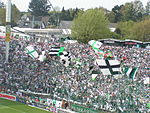Gladbach Abbey

Gladbach Abbey was a Benedictine abbey founded in 974 by Archbishop Gero of Cologne and the monk Sandrad from Trier. It was named after the Gladbach, a narrow brook that now runs underground. The abbey and its adjoining villages grew into the town of Gladbach, incorporated in the 1360s, the origin of the present city of Mönchengladbach in North Rhine-Westphalia. In 1802 the abbey was occupied by troops under the French occupation and secularised; its great library was dispersed. From 1805 to 1835 it was used as a textile mill. In 1835 the city authorities acquired the main building to replace the old Rathaus, which was demolished. This now constitutes the present Rathaus Abtei. The remaining monastic buildings were also acquired by the city one by one, for the accommodation of municipal offices.
Excerpt from the Wikipedia article Gladbach Abbey (License: CC BY-SA 3.0, Authors, Images).Gladbach Abbey
Rathausplatz, Mönchengladbach Gladbach (Nord)
Geographical coordinates (GPS) Address External links Nearby Places Show on map
Geographical coordinates (GPS)
| Latitude | Longitude |
|---|---|
| N 51.1928 ° | E 6.4311 ° |
Address
Rathaus Abtei
Rathausplatz 1
41061 Mönchengladbach, Gladbach (Nord)
North Rhine-Westphalia, Germany
Open on Google Maps









